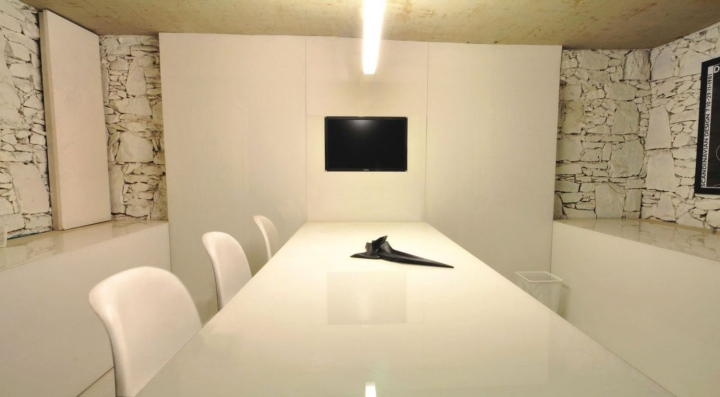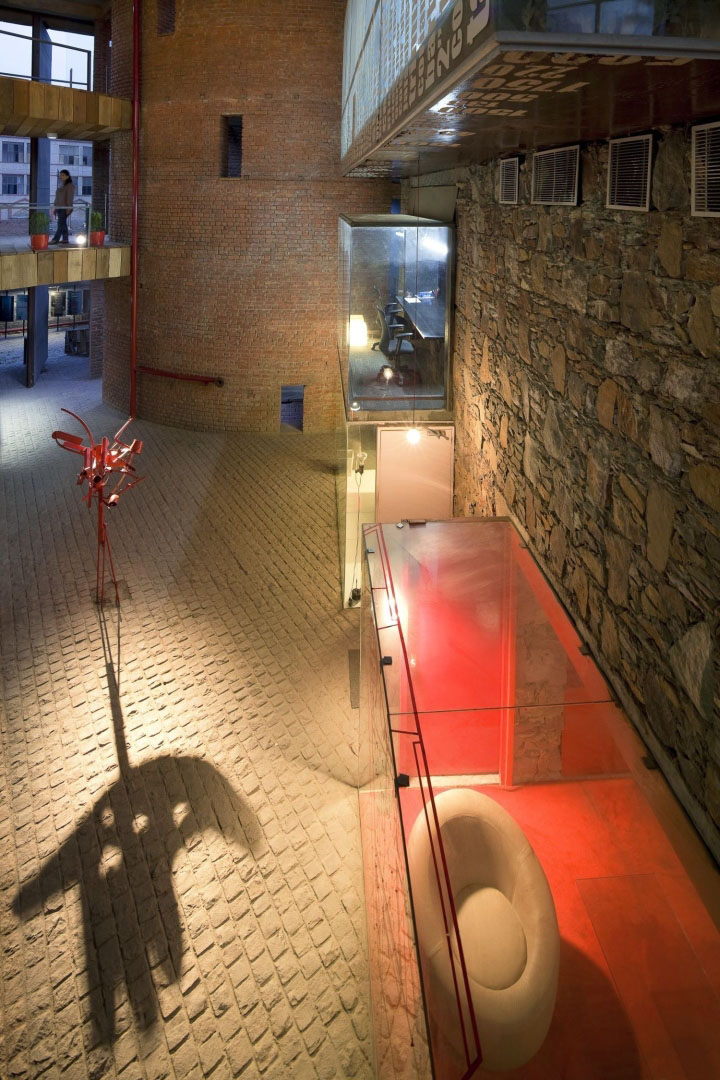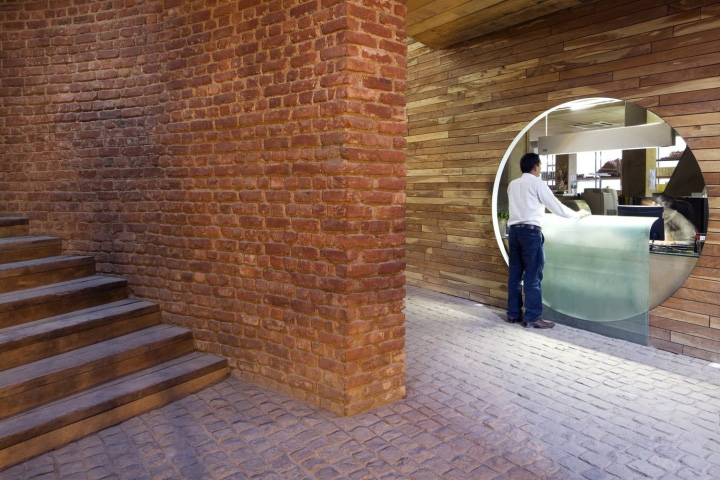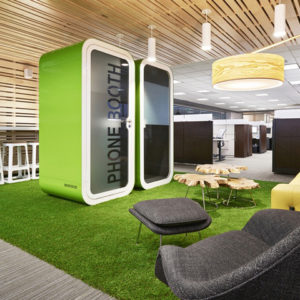


c – 28c, is the design studio Archohm’s Head office in India. Often labeled as a design fort, the design of the studio reflects the ‘mad and fun’ design philosophy of Archomites. The site is located in an extremely dense suburban area within the vicinity of the NCR With a built up area of 4,000 sq meters. Amidst theurban city conditions, the triangulated plot is flanked by, the ‘Jama mosque’ on one side, industrial factories on the other and a large slum development on the third.

Standing tall at a height of 10m, Archohm’s Corten steel entrance door creates an intimidating first impression. Its revolving nature and access through a ramp, gives the building its character and symbolizing the continuity of the outer street into this ‘square’, the atrium for visitors. A moat augments the medieval modern dialogue with a revolving bridge thatconnects the main studio tothe front garden. Red Sandstone clads the boundary wall, with etchings that depict the focus areas of the firm.

The main building is divided into five components, each of which are defined and exaggerated by the use of distinct materials; concrete, glass, brick, stone and metal. Each component has been designed keeping in mind climatic, contextual and functional requirements.

The main studio space takes the north face, and is an economical r.c.c. framed structure wrapped in glass. The glazed façade brings in diffused light, to create optimum working conditions. To distinguish a sense of identity within the various sectors of the studio, each department is assigned a particular color in the building section and elevation. Architecture is brown, Interiors is orange, Electrical is yellow, Plumbings in blue and Finance is red.

The external façade is transparent and houses every department’s files, documents, physical models and material samples, creating a dynamic visual collage of materials and colours that is able to represent life at Archohm, inside out! Large circular cutouts connect the floors vertically. Staggered in location, these openings visually connect across three levels. To add vitality, each cutout is equipped with its own highlight. From poles to slides, the features are varied, add energy and are quite well-used!

Placed near the entrance, a robust, circular ‘rotunda’ of brickaccommodates all services. Dominating the central hollow core, hangs a yellow felt manuscript, with laser cut, inspiring excerpts from the ‘Fountain Head’. The apt placement of the rotunda ensures efficient division of traffic, as visitors reach directly to the meeting rooms.

At every half floor height, washrooms are placed with designed wooden benches for waiting. This service core houses the electrical substation at the base and water works on top. All services are concentrated into this block and all lines run exposed for economy and maintenance.

The roof top of this rotunda, transfers into a perfectly circular amphitheater that can accommodate upto a hundred people. Lined with white china mosaic, it helps to reflect unwanted heat and provides an excellent space to conduct formal/informal office gatherings.

The southern face is obstructed with a three-meter thick stone wall. This wall is hollowed at various levels to house playful glass, transparent meeting rooms that create an incredible internal visual dialogue. Looking onto the entrance atrium and facing the main studio, these meeting rooms add a sense of transparency to the office layout. In all, there are four such meeting rooms, each with its own colour, texture and style.

The metal roof of the atriumrises three floors high, extending itself into a metal box, as it scales into a badminton court for the studio, behind the stone wall. The vastness of the court helps it double up as an exhibition and a lecture space as and when required.

Last but not least, is the triangle of concrete that gets its shape by virtue of the plot. Its basement, housesfully equipped boutique studio guest rooms with their own open air theatre.On the first floor, sits the orange board room adorned at the centre with atriangular concrete table. Considered as one of Archohm’s highlights, this table was shunned by structural engineers due to its central support and extreme cantilevered design. However, true to Archohm spirit, the design was well detailed and finally implemented, leaving many amazed!

At the terrace, the concrete triangle converges into a skylight and swimming pool which, is covered by a cooling white canopy. Beyond the pool, lies an open garden that overlooks the office cafetaria. A large triangular volume, double height and top light lit is one of the most spectacular design studio spaces of the office.

The bare concrete walls, glass roof and terracotta floors make this contemporary space fairly earthy. The space is punctuated by art and design, designer lights and furniture pieces. This brings the entire archohm philosophy together in its chief designer’s personal domain.

The entire office space is conceived as a vibrant and active space, interspersed with distinctive mediations, unique, out-of-the box ideas that demonstrate and inspire creativity amongst Archohmites. Being used as a live canvas, the exhibit of materials, colours , textures, exposed surfaces and play of form, makethe studio a 3-dimensionallibrary! Not only does this help clients visualize designs but also, helps designers keep design alive!

Through small initiatives, creative expressions and a sheer mad and fun working ambience, Archohmites have made their office a thought provoking gesture, representing their journey, exposure and experience over time.At the centre of the entrance atrium stands a metal sculpture, christened ‘the hand’.

Crafted out of scrap material from the studio’s backyard, this abstract art piece, radically transforms, on being subject to light. Seen in its shadow, is the exact reflection of Le Corbusier’s ‘Hand’. Made to welcome and introduce visitors to Archohm’s philosophy of mad, fun but meaningful design. This sculpture traps the soul of Archohm

Architects: Archohm Studio
Location: Noida, India
Project Team: Sourabh Gupta, Anindya Ghosh, Sanjay Rawat, Shiv Dutt Sharma
Electrical Engineering: Amit Das
Photographs: Humayun Khan, Andre Fanthome







http://karmatrendz.wordpress.com/2012/11/09/c-28-c-by-archohm-studio/#























Add to collection










